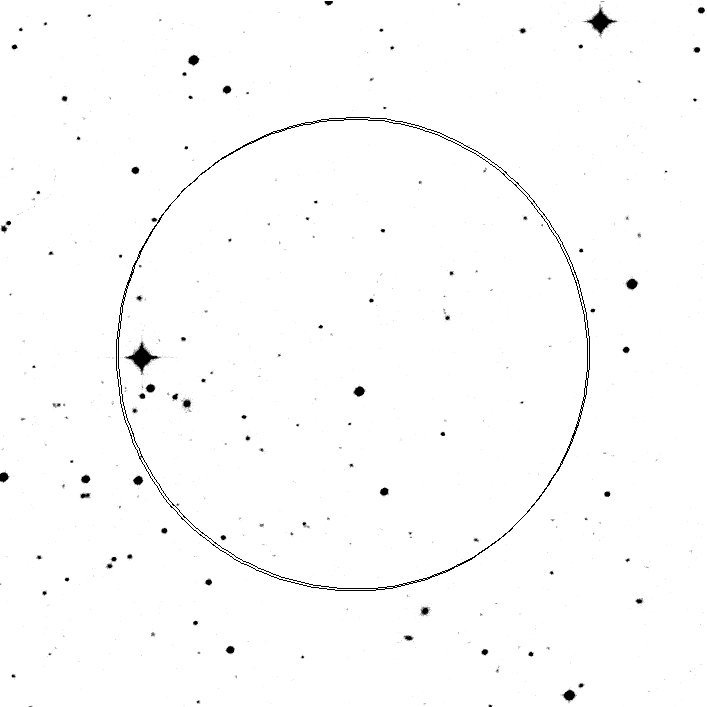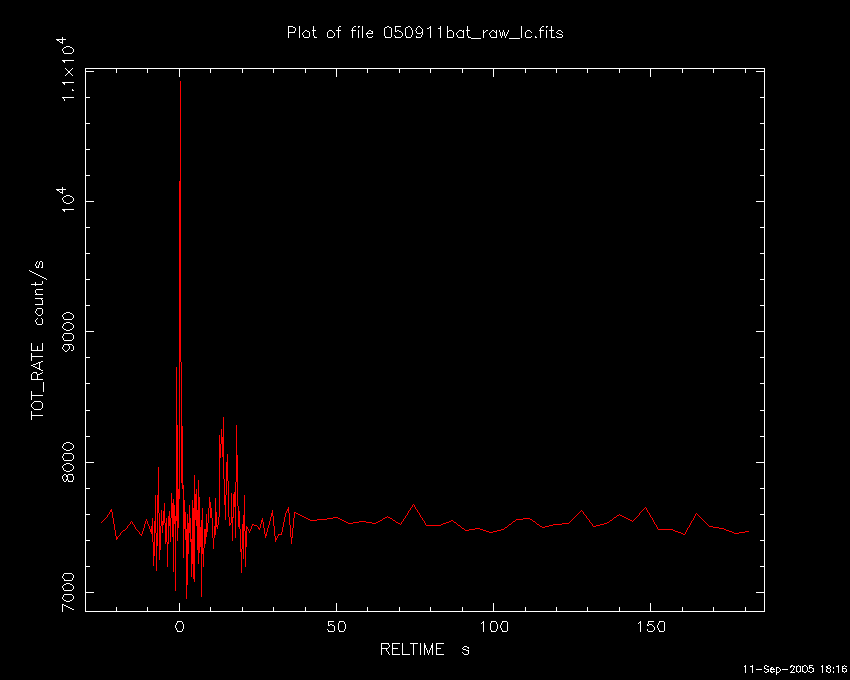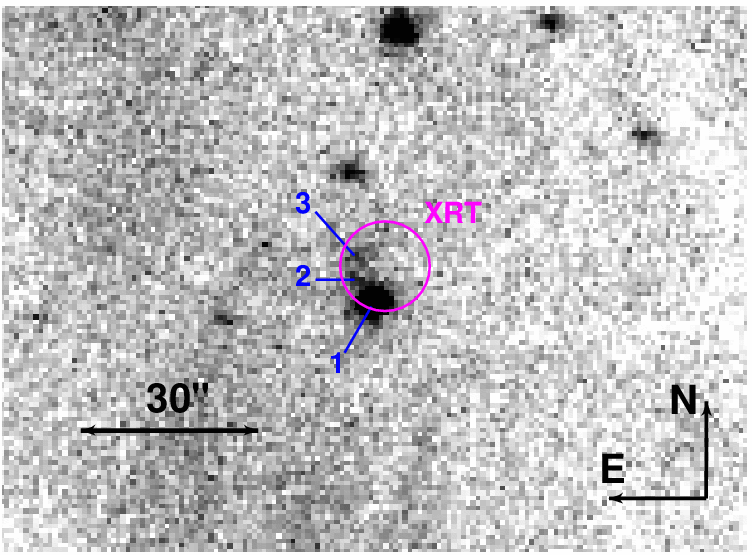- GCN/BACODINE POSITION NOTICE
TITLE: GCN/SWIFT NOTICE
NOTICE_DATE: Sun 11 Sep 05 15:59:48 UT
NOTICE_TYPE: Swift-BAT GRB Position
TRIGGER_NUM: 154630, Seg_Num: 0
GRB_RA: 13.692d {+00h 54m 46s} (J2000),
13.759d {+00h 55m 02s} (current),
13.104d {+00h 52m 25s} (1950)
GRB_DEC: -38.861d {-38d 51' 37"} (J2000),
-38.830d {-38d 49' 46"} (current),
-39.131d {-39d 07' 52"} (1950)
GRB_ERROR: 4.00 [arcmin radius, statistical only]
GRB_INTEN: 2810 [cnts] Image_Peak=151 [image_cnts]
TRIGGER_DUR: 0.512 [sec]
TRIGGER_INDEX: 68 E_range: 15-50 keV
BKG_INTEN: 33311 [cnts]
BKG_TIME: 57560.00 SOD {15:59:20.00} UT
BKG_DUR: 8 [sec]
GRB_DATE: 13624 TJD; 254 DOY; 05/09/11
GRB_TIME: 57573.84 SOD {15:59:33.84} UT
GRB_PHI: 74.49 [deg]
GRB_THETA: 28.28 [deg]
SOLN_STATUS: 0x3
RATE_SIGNIF: 18.84 [sigma]
IMAGE_SIGNIF: 8.81 [sigma]
MERIT_PARAMS: +1 +0 +0 -1 +1 +6 +0 +0 +75 +1
SUN_POSTN: 169.90d {+11h 19m 36s} +4.35d {+04d 20' 53"}
SUN_DIST: 139.28 [deg]
MOON_POSTN: 260.28d {+17h 21m 08s} -28.07d {-28d 04' 00"}
MOON_DIST: 88.79 [deg]
MOON_ILLUM: 52 [%]
GAL_COORDS: 299.75,-78.25 [deg] galactic lon,lat of the burst (or transient)
ECL_COORDS: 353.93,-40.46 [deg] ecliptic lon,lat of the burst (or transient)
COMMENTS: SWIFT-BAT GRB Coordinates.
COMMENTS: This is a rate trigger.
COMMENTS: A point_source was found.
COMMENTS: This does not match any source in the on-board catalog.
COMMENTS: This does not match any source in the ground catalog.
COMMENTS: This is a GRB.
- red DSS finding chart
ps-file

- GCN/SWIFT NOTICE
TITLE: GCN/SWIFT NOTICE
NOTICE_DATE: Sun 11 Sep 05 16:03:06 UT
NOTICE_TYPE: Swift-BAT GRB Lightcurve
TRIGGER_NUM: 154630, Seg_Num: 0
GRB_RA: 13.692d {+00h 54m 46s} (J2000),
13.759d {+00h 55m 02s} (current),
13.104d {+00h 52m 25s} (1950)
GRB_DEC: -38.861d {-38d 51' 37"} (J2000),
-38.830d {-38d 49' 46"} (current),
-39.131d {-39d 07' 52"} (1950)
GRB_DATE: 13624 TJD; 254 DOY; 05/09/11
GRB_TIME: 57573.84 SOD {15:59:33.84} UT
TRIGGER_INDEX: 68
GRB_PHI: 74.49 [deg]
GRB_THETA: 28.28 [deg]
DELTA_TIME: 65459.00 [sec]
TRIGGER_DUR: 0.512 [sec]
LC_URL: sw00154630000msb.lc
SUN_POSTN: 169.90d {+11h 19m 36s} +4.35d {+04d 20' 53"}
SUN_DIST: 139.28 [deg]
MOON_POSTN: 260.28d {+17h 21m 08s} -28.07d {-28d 04' 00"}
MOON_DIST: 88.79 [deg]
MOON_ILLUM: 52 [%]
GAL_COORDS: 299.75,-78.25 [deg] galactic lon,lat of the pointing direction
ECL_COORDS: 353.93,-40.46 [deg] ecliptic lon,lat of the pointing direction
COMMENTS: SWIFT-BAT GRB Lightcurve.
COMMENTS:
COMMENTS: The next comments were copied from the BAT_POS Notice:
COMMENTS: This is a rate trigger.
COMMENTS: A point_source was found.
COMMENTS: This does not match any source in the on-board catalog.
COMMENTS: This does not match any source in the ground catalog.
COMMENTS: This is a GRB.

- GCN notice #3961
K. Page (U. Leicester), M. Chester (PSU), J. Cummings (GSFC/NRC),
N. Gehrels (GSFC), J. Kennea (PSU), C. Markwardt (GSFC/UMD),
D. Palmer (LANL), T. Sakamoto (GSFC),
on behalf of the Swift team:
At 15:59:34 UT, Swift-BAT triggered and located GRB050911 (trigger=154630).
The BAT on-board calculated location is RA,Dec 13.692, -38.861
{00h 54m 46s, -38d 51' 37"} (J2000), with an uncertainty of 3 arcmin
(radius, 90% containment, stat+sys). The BAT light curve shows multi-
peaks with short peaks (< 500 msec) at T-1 sec and T+0 sec, and a broader
peak between T+10 to T+20 sec. The peak count rate was ~1000 counts/sec
(15-350 keV), at the time of the trigger.
Due to the Earth limb observing constraint, the spacecraft could not slew
immediately. The burst will become visible to the Narrow Field Instruments
at 16.52 UT (approximately 51 minutes after the trigger), at which point
XRT data will be obtained.
- GCN notice #3962
E. Berger (Carnegie Observatories) reports:
"The position of GRB 050911 is located about 3.5 arcmin from the center of
a galaxy cluster (EDCC 493; diameter ~ 20 arcmin). Several galaxies in
this field have a redshift of about 0.165, measured in the Las Campanas
Redshift Survey (LCRS). If GRB 050911 is a short burst (as may be
indicated by the initial short duration pulses; GCN 3961), then it is
possible that it is associated with EDCC 493, and is therefore located at
z~0.16. We note that the prompt emission exhibits a second peak at t+10
to t+20 sec (GCN 3961), but this may be a softer component as observed in
GRBs 050709 and 050724."
- GCN notice #3964
J. Tueller (GSFC), L. Barbier (GSFC), S. Barthelmy (GSFC),
M. Chester (PSU), J. Cummings (GSFC/NRC), E. Fenimore (LANL),
N. Gehrels (GSFC), D. Hullinger (UMD), H. Krimm (GSFC/USRA),
C. Markwardt (GSFC/UMD), F. Marshall (GSFC), D. Palmer (LANL),
A. Parsons (GSFC), T. Sakamoto (GSFC/NRC), G. Sato (ISAS),
on behalf of the Swift-BAT team:
Using the data set from T-60 to T+120 sec from the recent telemetry
downlink, we report further analysis of Swift-BAT GRB 050911
(trigger #154630) (Page, et al., GCN 3961). The refined BAT ground
position is (RA,Dec) = 13.718, -38.862 { 0h 54m 52.4s, -38d 51' 42.8"}
[deg; J2000] +-2.8 arcmin, (radius, sys+stat, 90% containment).
The partial coding was 43 %.
The mask-weighted BAT light curves show at least three peaks.
The first two peaks are at T-1 and T+0 sec, each with a duration of
0.5 sec. The third peak is a slow rise and decay from T+10 to T+20 sec.
The third peak is not appreciably softer than the first two,
as suggested by Berger (GCN Circ 3962). Thus the burst is very likely
in the long GRB category. T90 (15-350 keV) is (16 +- 2) sec.
(estimated error including systematics).
The power law index of the time-averaged spectrum is 1.87 +- 0.03.
The fluence in the 15-150 keV band is (3.0 +- 0.6) x 10^-7 erg/cm2.
The 1-sec peak photon flux measured from T0-0.1 sec in the 15-150 keV
band is (1.3 +- 0.2) ph/cm2/sec. All the quoted errors are at the 90%
confidence level.
- GCN notice #3965
P. Tristram (Univ. of Canterbury, New Zealand),
A. J. Castro-Tirado, S. Guziy, A. de Ugarte Postigo,
M. Jelinek, J. Gorosabel (IAA-CSIC, Granada, Spain),
and Ph. Yock (Univ. of Auckland, New Zealand)
report:
"We have imaged the GRB 050911 error box provided by Swift/BAT
(Page et al. GCN 3961) with the 0.6m telescope (+MOA camera)
at Mt. John Observatory. 5 x 300s second integrations in
the wide R-band filter were taken starting at 16:35:16 UT
(i.e. 36 min after burst). Within the refined Swift/BAT error
box (Tueller et al. GCN 3964), the coadded image does not
reveal any variable object down to R~21 when comparing to
the DSS-2."
This message can be quoted.
- GCN notice #3966
E. Berger (Carnegie Observatories) and A. Boss (Carnegie DTM) report:
"We observed the BAT error circle of GRB 050911 (GCN #3961) with the du
Pont 100-inch telescope at Las Campanas Observatory on 2005, Sep. 12.125
UT (13 hours after the burst). A total of 16 minutes were obtained in
I-band with a seeing of about 0.9". A comparison to DSS reveals no new
objects to the limit of the survey."
- GCN notice #3967
K. Page (U. Leicester), J. Kennea (PSU) and D. Burrows (PSU) report on
behalf of the Swift XRT team:
We have analysed the first 3 orbits of ground data from GRB050911 (BAT
Trigger 154630). There is a previously uncatalogued X-ray source within
the BAT error circle at a position of
RA(J2000): 00:54:37.7
Dec(J2000): -38:50:57.7
with an uncertainty of 7.5 arcsec radius (90% containment). This is 107
arcsec from the BAT position reported in GCN 3961 (Page et al.)
Because of the limited amount of data, starting only 4.6 hours after the
trigger, it is not yet possible to confirm that this source is definitely
fading. However, it is the best candidate for the XRT afterglow.
- GCN notice #3968
A. J. Castro-Tirado, A. de Ugarte Postigo, S. Guziy,=20
M. Jelinek, J. Gorosabel (IAA-CSIC, Granada, Spain),
P. Tristram (Univ. of Canterbury, New Zealand) and=20
Ph. Yock (Univ. of Auckland, New Zealand)
report:
"We have examined the position of the Swift/XRT=20
candidate afterglow for GRB 050911 (Page et al.=20
GCNC 3967) in our 0.6m telescope (+MOA camera)=20
images (Tristram et al. GCNC 3965). In the 7.5"
radius X-ray error box, we find three optical=20
sources, which seem to be detected as well in the=20
corresponding DSS-2 red-band plates. Coordinates
(J2000) yield:
#1 00:54:37.87 -38:51:03.6
#2 00:54:38.10 -38:50:59.7
#3 00:54:38.14 -38:50:56.0
Error= 0.5"
An ID-chart is posted at:
http://www.iaa.es/~deugarte/GRBs/050911/GRB050911.gif
Further observations are in progress."
This message can be quoted."

- GCN notice #3969
A. A. Breeveld (UCL-MSSL), K. Page (U. Leicester), T. S. Poole
(UCL-MSSL), F. Marshall (GSFC), M. Chester, P. Meszaros,
J. Nousek (PSU) on behalf of the Swift/UVOT team:
UVOT started observing GRB050911 16408 s (4.56 hours) after the
burst (Page et al. GCN 3961). The delay was caused by firstly
an earth limb constraint and then Swift spacecraft loss of lock
on the star tracker. No new source was found within the XRT error
circle (Page et al. GCN 3967) to the following upper limits.
Filter T_range (s) Exp (s) 3sig UL
V 21591-22041 900 20.2
B 16408-17291 883 21.0
B 28287-28870 583 20.8
U 27380-28280 900 20.9
UVW1 26473-27373 900 21.2
UVM2 22498-23081 583 20.9
UVW2 32261-32961 700 21.4
Where T_range is the time range post-trigger over which the summed
images were accumulated and Exp is the total exposure time of the
summed image. The magnitude upper limits are not corrected for
extinction.
This message may be cited.
- GCN notice #3972
E. Berger (Carnegie Observatories), B. P. Schmidt (RSAA, ANU), A. M.
Soderberg (Caltech), and A. Boss (Carnegie DTM) report:
"We obtained second set of I-band observations of GRB 050911 with the du
Pont telescope at LCO on 2005, Sep. 12.39 UT (18.5 hours after the burst).
Digital subtraction of this observation from the one obtained 13 hours
after the burst (GCN #3966) reveals no variable sources within the XRT
error circle (GCN #3967) to a 3-sigma limit of I>21.9 mag in comparison to
the UCAC2 star at RA=00:54:43.4587, DEC=-38:54:00.674."
- GCN notice #3976
K. Page (U. Leicester), D. Burrows (PSU), N. Gehrels (GSFC), P. O'Brien
(U. Leicester), F. Marshall (GSFC) and P. Boyd (GSFC-UMBC) report on
behalf of the Swift-XRT team:
Upon analysis of 29 ks of data, starting 4.6 hours after the BAT detected
GRB050911 (trigger number 154630; GCN 3961), no fading X-ray source is
found within the BAT refined error circle (GCN 3964; Tueller et al.) The
source suggested in GCN 3967 (Page et al.) is found to constant over time,
so is not believed to be the afterglow.
We place a 3 sigma upper limit of 6.7e-4 count s^-1 on the count-rate,
which corresponds to an unabsorbed flux of 2.8e-14 erg cm^-2 s^-1 (over
0.3-10 keV), assuming a Crab-like spectrum. Since this GRB looks like a
real burst in the BAT data, we conclude that it must have had a
rapidly-decaying X-ray afterglow to have faded below the XRT sensitivity
in 4.6 hours.
- astro-ph/0512358 from 14 Dec 2005
Page: GRB 050911: a black hole - neutron star merger or a naked GRB
GRB 050911, discovered by the Swift Burst Alert Telescope, was not seen 4.6
hr later by the Swift X-ray Telescope, making it one of the very few X-ray
non-detections of a Gamma-Ray Burst (GRB) afterglow at early times. The
gamma-ray light-curve shows at least three peaks, the first two of which (~T_0
- 0.8 and T_0 + 0.2 s, where T_0 is the trigger time) were short, each lasting
0.5 s. This was followed by later emission 10-20 s post-burst. The upper limit
on the unabsorbed X-ray flux was 1.7 x 10^-14 erg cm^-2 s^-1 (integrating 46 ks
of data taken between 11 and 18 September), indicating that the decay must have
been rapid. All but one of the long bursts detected by Swift were above this
limit at ~4.6 hr, whereas the afterglows of short bursts became undetectable
more rapidly. Deep observations with Gemini also revealed no optical afterglow
12 hr after the burst, down to r=24.0 (5-sigma limit). We speculate that GRB
050911 may have been formed through a compact object (black hole-neutron star)
merger, with the later outbursts due to a longer disc lifetime linked to a
large mass ratio between the merging objects. Alternatively, the burst may have
occured in a low density environment, leading to a weak, or non-existent,
forward shock - the so-called 'naked GRB' model.
![]() Previous IAU Circulars
Previous IAU Circulars 

